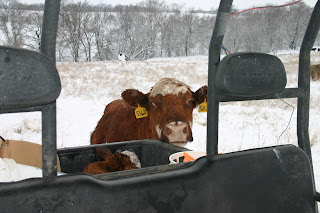Bloggers note, Today's blog will be dealing with aspects of bovine reproduction and may not be suitable for young children, if you are sharing this with your kids please read first then decide if you want to answer their questions.
Today on the farm I took a bull to Hawkeye Breeders in Adel to be collected. Hawkeye Breeders is a Bull Stud. A Bull Stud is a facility where you can take your bull to be kept for the purpose of the collection, processing, and storage of his semen. It was an especially fun day for me because I was able to have some of my LI classmates join me at Hawkeye Breeders to learn more about the experience. When we are in Sioux Center if any of you have questions about the process just ask Paul, Bob, or Nicole (Pauls wife Anne joined us as well).
The reason I am collecting the bull and use AI is to deliver you a consistent high quality eating experience, and because he is the best calving ease bull I have ever used on heifers (meaning I do not have to help his calves at delivery). The calves I have reviewed out of this bull consistently grade prime and choice. These traits have a positive effect on my profitability and your satisfaction with my product. When you have an animal with the proven traits you need, collection and AI is a good option to consider.
I'll do my best to explain this somewhat unique aspect of cow calf production.
Step one, the handler in this photo is leading the teaser animal. The purpose of the teaser is to stimulate my bull (the one in the corner) to mount and ejaculate.
Step two, This is the best, although maybe not the safest way to collect a bull. You can see the second handler moving in to catch the collection. One of the issues with collection is the bulls really don't like a bunch of voyeurs standing around taking pictures. To his credit my bull was pretty cooperative.
Once the semen is caught it is taken to a lab in the barn to be analyzed for the following:
Concentration, which is the volume of live sperm in the collection.
Mobility, which represents the sperms activity (think fast straight swimmers, I'm looking for the Michael Phelps of sperm).
Morphology, this is the condition of the sperm, you don't want deformities or sperm who can't swim straight.
If the sperm passes the test it is then taken to the main lab for processing.
Here we have our class anthropologist examining the origin of bovine life.
Here we are at the lab. Assuming the semen passes its quality tests it will then be separated into straws like these in the photo. One ejaculation can yield from 30 to 1,000 straws. Each straw could potentially impregnate a cow.
When we Artificially inseminate cows at Pinhook Farm we get about 60% settled AI then the rest are bred by bulls.
Once the semen is processed it will be kept in cryogenic storage containers like these until its time to put it in a cow.
The technology to store semen is only about 50 years old so we don't know how long it will keep. However, there is semen in these tanks that is 50 years old that has been thawed and successfully impregnated cows. So it appears that as long as frozen properly it can be stored for perpetuity.
Side note, Walt Disney is crogenically preserved in , with the hope that someday technology will allow him to be thawed out and brought back to life like the sperm in these tanks, who knows.
Here's a view inside one of the tanks, Hawkeye is equipped to export all over the world and has over 4,000,000 straws stored for producers worldwide.
Hawkeye breeders is a great example of a family run agribusiness that is a major part of our states economy. They are in a business that could be anywhere in the world, but they have chosen Iowa. Were lucky to have them.
Nicole and her friend Joy have been assigned the task of naming the bull, hopefully by our Sioux Center session he will have a name. On the other hand an old cowboy once told me "never name something you might have to eat".












































